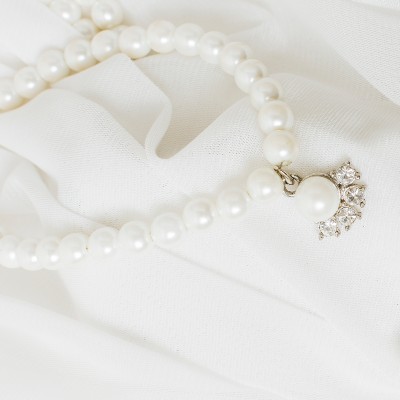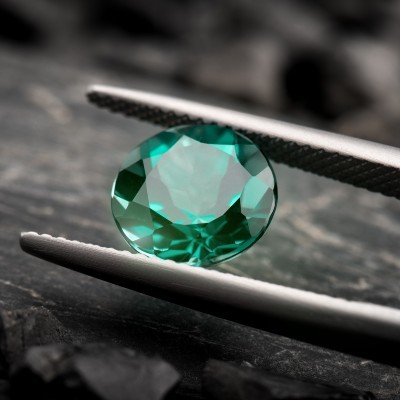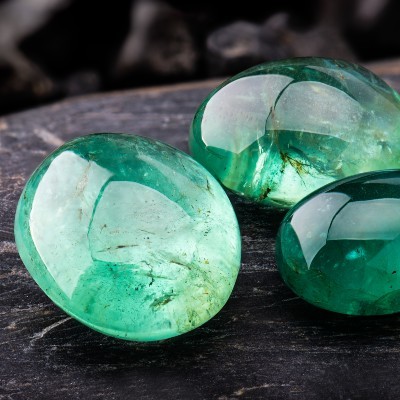Gemstone

Diamond
Diamond is one of the best-known and most sought-after gemstones. They have been used as decorative items since ancient times. Diamonds are used in engagement rings. The practice is documented among European aristocracy as early as the 15th century. Diamonds are such a highly traded commodity that multiple organizations have been created for grading and certifying them based on the "four Cs", which are Color, Cut, Clarity, and Carat.
Carat
The carat weight measures the mass of a diamond. One carat is defined as 200 milligrams. The price per carat does not increase linearly with increasing size. Instead, there are sharp jumps around milestone carat weights, as demand is much higher for diamonds weighing just more than a milestone than for those weighing just less.
Color
The color can be graded into several scales. Start from grade D to Z. The majority of mined diamonds fall between white and pale yellow or brown; what is known as the normal color range. Diamonds of more intense color (usually yellow, but in some cases red, green or blue) are termed fancy color diamonds. Black diamonds are also fancy color diamonds.
- Colorless:D, E, F
- Near Colorless:G, H, I, J
- Faint:K, L, M
- Very Light:N, O, P, Q, R
- Light:S, T, U, V, W, X, Y, Z
Clarity
Clarity is a measure of internal defects of a diamond called inclusions. Inclusions may be crystals of a foreign material or another diamond crystal, or structural imperfections such as tiny cracks that can appear whitish or cloudy. The number, size, color, relative location, orientation, and visibility of inclusions can all affect the relative clarity of a diamond.
- Flawless
- Internally Flawless
- Very Very Slightly Included
- Very Slightly Included
- Slightly Included
- Included
Cut
Diamond cutting is the art and science of creating a gem-quality diamond out of mined rough. The cut of a diamond describes the manner in which a diamond has been shaped and polished from its beginning form as a rough stone to its final gem proportions. The cut of a diamond describes the quality of workmanship and the angles to which a diamond is cut. Diamonds are cut into a variety of shapes that are generally designed to accentuate these features.

Pearl
A pearl is a hard, glistening object produced within the soft tissue of a living shelled mollusk or another animal, such as fossil conulariids. Just like the shell of a mollusk, a pearl is composed of calcium carbonate The ideal pearl is perfectly round and smooth, but many other shapes, known as baroque pearls, can occur. The finest quality of natural pearls have been highly valued as gemstones and objects of beauty for many centuries. Because of this, pearl has become a metaphor for something rare, fine, admirable and valuable. The most valuable pearls occur spontaneously in the wild, but are extremely rare. These wild pearls are referred to as natural pearls. Cultured or farmed pearls from pearl oysters and freshwater mussels make up the majority of those currently sold. Most saltwater cultured pearls are grown with beads. Trade names of cultured pearls are Akoya, white or golden South sea, and black Tahitian.
Fine quality natural pearls are very rare jewels. Their values are determined similarly to those of other precious gems, according to size, shape, color, quality of surface, orient and luster. Single natural pearls are often sold as collectors' items, or set as centerpieces in unique jewelry.
Tahitian pearls, frequently referred to as black pearls, are highly valued because of their rarity. Black pearls are very rarely black: they are usually shades of green, purple, aubergine, blue, grey, silver or peacock (a mix of several shades, like a peacock's feather).
South Sea pearls are the largest and rarest of the cultured pearls – making them the most valuable, prized for their exquisitely beautiful 'orient' or luster. White and silver colored South Sea pearls tend to come from the Broome area of Australia, while golden colored ones are more prevalent in the Philippines and Indonesia.
The value of the pearls in jewelry is determined by a combination of the luster, color, size, lack of surface flaw and symmetry that are appropriate for the type of pearl under consideration. Among those attributes, luster is the most important differentiator of pearl quality according to jewelers.
All factors being equal, however, the larger the pearl the more valuable it is. Large, perfectly round pearls are rare and highly valued.

Emerald
Emeralds are green precious gemstones that are mined in various geological settings. They are minerals in the beryl group of silicates. For more than 4,000 years, emeralds have been among the most valuable of all jewels on Earth. Colombia, located on the continent of South America, is the country that mines and produces the most emeralds for the global market. The three major locations: Muzo, Coscuez, and Chivor. Zambia is the world's second biggest producer responsible for 20% of the world's production of gem-quality stones.

Jadeite
Jade refers to an ornamental mineral, mostly known for its green varieties, though appears naturally in other colors as well, notably yellow and white. Jade can refer to either of two different silicate minerals: nephrite or jadeite. Jade is featured prominently in East Asian, South Asian and Southeast Asian art, but also has an important place in many other cultures. In the history of the art of the Chinese empire, jade has had a special significance, comparable with that of gold and diamonds in the West.
Today, it is estimated that Myanmar is the origin of upwards of 70% of the world's supply of high-quality jadeite. Most of the jadeite mined in Myanmar is not cut for use in Myanmar, instead being transported to other nations, primarily in Asia, for use in jewelry and other products.

